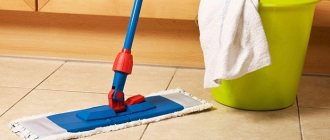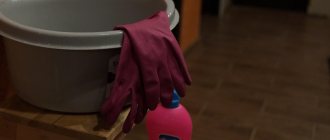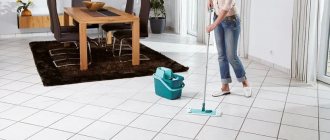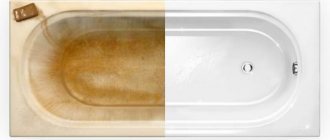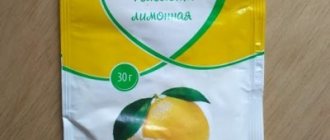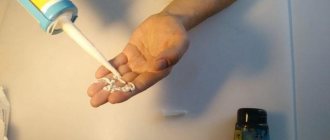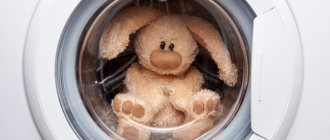As plumbing fixtures are used, their appearance deteriorates. This occurs due to soap deposits, dust, and other contaminants. To avoid having to use aggressive products to remove stubborn stains, it is recommended to ensure regular maintenance of your plumbing fixtures. First you need to decide how to clean the bathtub white at home, then study the instructions for use. This will prevent the coating from being destroyed.
Stubborn dirt in the bathroom.
Preparing for cleaning
There are universal and highly specialized means. They are used for different purposes. For example, substances of the first group will help get rid of any kind of stubborn dirt. Highly specialized ones, on the contrary, remove only some stains. For this reason, you must first determine the type of contamination, which will increase the effectiveness of the detergent. Possible options:
Rust may appear due to a breakdown of common house pumping equipment.
- lime: traces of water drops remain on the mixer and the surface of the bowl, the reason lies in its increased hardness;
- soap scum: this leaves stains of different colors (which depends on the shade of the soap) or a whitish film covering the entire bowl; it forms during the process of taking a shower or bath;
- rust: a consequence of a breakdown of common house pumping equipment or replacement of communications; sometimes low-quality water is supplied to the facility;
- mold - develops in conditions of high humidity and when air circulation is disrupted;
- colored spots are a consequence of careless hair dyeing at home, brilliant green or potassium permanganate is spilled;
- traces of repair (plaster, cement mortar, sealant, polyurethane foam, etc.).
Depending on the nature of the contamination, a cleaning method is selected. In this case, you need to take into account the properties of the bowl’s coating. If you do not follow these recommendations, you can ruin your plumbing. Use acidic materials and powders with caution. The latter are characterized by abrasive properties and will easily damage the coating of the plumbing bowl.
Causes of stains in the bathtub and their nature
To quickly and effectively get rid of a problem, you need to understand the reasons that caused it. The list is quite extensive and includes:
- interaction with water;
- high humidity;
- sudden changes in temperature;
- residues of detergents and cleaning products;
- faulty plumbing equipment.
You must not forget that the bath should be used only for its intended purpose. Regular violation of this rule is fraught with the appearance of blockages and destruction of the protective layer.
Soap scum is the result of using gels, shampoos and other detergent compositions. Contrary to popular belief, it is unlikely that you will be able to completely remove the film by simply rinsing the bathtub. Over time, it eats more and more into the surface of the product, negatively affecting its appearance. In this case, you cannot do without special tools.
Limescale deposits are a sign that the tap water is too hard. Yellow stains are caused by leaks, and rust is caused by high iron content. Mold and mildew can be found between the tiles and the bathtub.
Cleaning methods without using chemicals
Ways to clean a bathtub at home.
To remove traces of various substances from the surface of the bathtub, remove plaque and rust, it is first recommended to use effective home remedies.
They differ from specialty chemicals in that they work gently. The coating will remain intact even after repeated use of substances prepared based on folk recipes.
However, this method also has disadvantages, such as low efficiency. With their help, you can wipe off fresh stains and remove light dirt. Moreover, increasing the dose of active components will not provide the required result.
Lemon acid
This product is moderately aggressive. The acid helps remove traces of rusty water. It will not remove complex stains, but it can significantly lighten the coating. It is necessary to use the acid correctly, which will increase its level of effectiveness. They use methods based on exposure to a concentrated solution and water containing a small amount of the substance. They are used in different cases. Algorithm of actions:
- Prepare a concentrated solution. To do this, stir 1 packet of acetic acid in 1 glass of water (250 ml). All surfaces of the plumbing fixture bowl are treated with the substance, but it is best to clean those areas where the yellow coating is more visible. Then the bath is left in this state for half an hour. During this time, the acid will penetrate the surface layer of the coating and destroy the contaminants. After half an hour, the product must be washed off the walls of the bowl.
- Use of a low concentration solution. Mix citric acid with water, for which use the above recipe. Then fill the bath with water to the hole at the top of the bowl (overflow) or to the level where a yellow coating has formed. It is necessary to pour the solution into water. The substance is left in the bath for 3 hours. If the stains are complex, the dark coating may lighten slightly. When fresh stains need to be removed, the cleaner helps restore the whiteness of the plumbing fixtures. After 3 hours, the solution is washed off with water, after emptying the bath.
Citric acid removes complex stains.
After applying the acid, you can rub the stains with baking soda. This method is chosen taking into account the type of coating of the bowl, since the abrasive is not suitable for all facing materials - it has a damaging effect.
Soda and vinegar
This combination is used only if individual substances do not provide the desired result. Subtleties of using soda:
- Prepare the slurry: mix soda with water. The number of components is arbitrary; it is important to obtain a thick substance at the output, which is characterized by a high viscosity index, which will not allow the substance to spread.
- The gruel is applied to all surfaces of the bowl of the plumbing fixture. If the coating material is insensitive to abrasive, rub the bowl with soda using a soft sponge. In other cases, soda does not need to be rubbed into surfaces so as not to damage the enamel.
- After 1 hour, you can remove the layer of slurry with a stream of water. Alternatively, you need to wait until the mixture dries, after which you can remove the dry powder. In such cases, you should not use hot water to clean the bowl.
A combination of baking soda and vinegar helps remove tough stains.
Clean the bathtub until it is snow-white; soda ash will help remove black deposits. The method of using such a powder is similar to the previously discussed option.
It is necessary to mix soda ash and baking soda, the ratio of components is 1:1. Then add water, but in a minimal amount, until a paste is obtained. It is necessary to wear gloves when working with soda ash. Apply the product to the surface of the bowl and leave for half an hour.
At this time, a vinegar solution is prepared. You need to mix 0.5 cups of essence and the same amount of bleach. The solution is applied to the walls of the bowl directly on top of the soda slurry. Leave the bath in this form for 30-40 minutes.
At the end of this period of time, you need to rub difficult stains on the surface of the bowl with a medium-hard sponge. Then the substance is washed off with water. Soda ash can remove the toughest stains from your bathtub.
Before using such a product, you need to do a test on a small and inconspicuous area, checking how the coating of the bowl will withstand its impact.
Removing rust
First, consider methods with ammonia, salt, and vinegar. These substances will help you easily get rid of light stains. They are used separately. It is enough to rub the stain for several minutes using ammonia or salt and vinegar. Lemon juice is used in the same way. However, the effectiveness of this product is low, so it is recommended to use it to regularly care for the bath bowl, removing light stains.
To remove rust, you need to use vinegar and bleach.
Another effective method against rust is to gradually apply a mixture of soda ash and baking soda, as well as a vinegar + bleach combination. It is distinguished by its universal action and comparative ease of use. Another method is also used:
- The inner walls of the bowl are treated with fine-grained moistened salt.
- A soft sponge must be moistened with turpentine, after which all surfaces of the bath are wiped. You need to work with gloves.
- The product must be washed off with water, and dishwashing liquid is added to enhance the effect.
Removing limescale
Mix baking soda and soda ash in equal parts. The powder needs to be moistened. Then the resulting slurry is applied to the walls of the bowl. After 30 minutes, the substance is removed from surfaces using a stream of water. You need to moisten paper napkins with vinegar and lay them out along the bottom of the bath. If required, the walls of the plumbing fixture are also covered. The substance must act for 5 hours. Then it is washed off.
How to get rid of scratches on the surface?
To get rid of scratches in your bathroom, you need to polish it. The algorithm of actions is as follows:
- Wash the surface of the bath and wait until it dries completely.
- Use fine abrasive sandpaper to treat the damaged area.
- Continue polishing until the surface becomes smooth.
- Treat the bath with felt.
- Apply non-abrasive wax polish to the scratch and rub the area again with a microfiber cloth.
- Rinse the bathtub with water and liquid detergent and wipe with a cloth.
This method will get rid of surface scratches. Read about removing scratches and chips on a bathtub here, and about restoring an acrylic bowl here.
Household chemicals for bathtub cleaning
There are a large number of options for such products, so it becomes difficult to choose the most suitable one. Before purchasing, study the information from the manufacturer on the label. This makes it possible to select a substance in accordance with the type of material from which the bathtub and lining are made.
Domestos is perfect for cleaning bathtubs with chemicals.
Instructions for use are often standard: the product is applied to the walls of the bowl and left for a certain period (depending on the brand). Upon completion, the substance is washed off with water. If you leave the product on the walls of the bowl, the lining may be damaged. They use products from different brands:
- Cif;
- Domestos;
- Mr. Muscle et al.
Washing the tiles
To clean bathroom tiles, you can use the following methods:
vinegar - it copes well with limescale;- laundry soap - it removes yellowness and has a whitening effect;
- soda ash - it dissolves well and does not leave scratches;
- store products - Mellerud liquid for tiles and stone (430 rubles), Help spray Clean bathroom (60 rubles), Cif anti-plaque bathroom spray (200 rubles), etc.
Compositions containing acid should not be applied to tile joints, as they can corrode the grout.
You can find out how to clean bathroom tiles here, and how to clean tile joints here.
Choosing a product depending on the bathroom material
When it is planned to use an aggressive substance, the properties of the material from which the plumbing fixture is made are studied. For example, a cast iron fixture cannot withstand the effects of acid and abrasives. However, acetic and citric acids can be used, which is due to their much milder effect compared to ready-made products. Ammonia is also used.
Acrylic
To clean such a bowl, you cannot use any acids or alkalis. This may damage the coating. Do not use alcohol- or chlorine-containing solutions. Lime is removed from the surface of the bath using washing powder diluted with water. It is permissible to use heated vinegar and salt. You can use turpentine. It is combined with fine-grained salt.
Turpentine is one of the acceptable cleaning agents for acrylic bathtubs.
Enameled
Do not use abrasive substances to clean this device. Allowed means:
- ammonia;
- hydrogen peroxide;
- vinegar;
- lemon juice;
- baking soda.
An enamel bath can be cleaned with lemon juice.
It is permissible to treat the walls with fine-grained salt; a thick slurry is prepared based on this component. A good result is provided by lemon juice in combination with ammonia. Despite the aggressive effects, it is permissible to use a mixture of soda ash and baking soda. Mustard powder is also used to clean enamel walls.
Features of cleaning acrylic, steel, cast iron and enamel bowls
Depending on the type of bathroom, the products that can be used to care for it will differ:
An acrylic bathtub cannot be cleaned with products containing acid, solvents and alcohol.
It is not recommended to bleach it with bleach and bleach. Soft gels are the best choice. Available means include washing powder, baking soda, and laundry soap.- An enamel bath should not be handled with brute force. It is not recommended to use caustic acids and chlorine. It can be washed with table vinegar, soda, ammonia.
- Cast iron bathtubs are covered with a layer of enamel, so the rules for caring for them are no different. For washing, it is recommended to use gel compositions without abrasive particles.
- Steel bathtubs do not tolerate water temperatures above 75 degrees. It is recommended to wash it after each use. If the surface is not heavily soiled, then it is enough to rinse it with soapy water and go over it with a soft sponge. You can get rid of difficult stains using baking soda and vinegar.
Regardless of the type of bathroom, no surface tolerates the use of brute force and caustic substances.
This article will tell you how and what to clean an acrylic bathtub, and this one for a cast iron bathtub.
Removing other types of contaminants
Even if the product is used as intended, various nuances may arise during the work process. In addition, the type of pollution is taken into account. Some substances have a stronger effect on a number of materials and, conversely, are almost ineffective when trying to influence other compounds.
How to clean a bathtub from potassium permanganate and brilliant green
A combination of citric acid and hydrogen peroxide will help remove traces of potassium permanganate.
These substances strongly stain any surface. To remove traces of potassium permanganate, use a combination of citric acid (or fresh lemon juice) and hydrogen peroxide.
The brilliant green solution is cleaned from surfaces using alcohol. However, this option is ineffective in cases where an acrylic bowl is installed.
How to clean a bathtub after renovation
Citric acid helps get rid of the effects of dust. Contaminants are removed with water, then the walls of the bowl are treated. Paint can be removed with solvents, but first you need to do a test to check how such a substance will affect the bathtub coating.
How to remove sealant
First, remove most of the silicone. Residues are removed using salt-based products. Considering that abrasive is used, this option is not suitable for all types of plumbing fixtures. Special products from the chemical industry are more effective.
Methods for removing sealant in the bathroom.
How to clean an old bathtub
The best option is soda ash. This substance penetrates deep into the coating, fills microcracks, due to which the walls of the bowl brighten. You can use a method using baking soda, soda ash and bleach with vinegar.
How to remove limescale or yellow deposits?
There are several ways to remove limescale from a bathtub:
- Soda with vinegar . They are mixed with each other and applied to the problem area.
- Lemon acid . It is diluted until completely dissolved (1 sachet per glass of water), and the bath is treated. Repeat the procedure again after 20 minutes, then rinse with clean water.
- Soda with hydrogen peroxide . For 1 part baking soda you will need 2 parts peroxide. The resulting solution is applied to the stain for an hour, after which it is washed off.
In addition to folk remedies, you can get rid of limescale and yellow deposits in the bathroom using store-bought formulations. They have a good effect:
- Cillit BANG gel plaque and rust (220 rubles),
- SARMA cleaning gel for bathtubs and sinks (100 rubles),
- Cif gel (150 rolls).
Read more about removing limescale here.
Bathroom care rules
You need to take 2 tips as a basis:
- Every day, wash the walls of the bowl with soapy water; instead, use liquid soap; use a sponge for application;
- at the end of the day, and best of all, after each use, the bath should be wiped dry, this will prevent the formation of limescale and the appearance of yellowness.
If colored stains appear (from hair dye, brilliant green, etc.), they must be removed immediately. If you leave complex contaminants on the surface of the bowl and continue to use it, the substance will penetrate deep into the lining structure. As a result, it will be difficult to remove such a stain.
How to eliminate sewer smell?
you get rid of unpleasant smell in the bathroom :
- check the operation of the ventilation, sewer system, pipe joints;
- improve ventilation draft;
- clean pipes and siphon from blockages;
- seal sewer joints.
Most often, the cause of the smell is a clog in the pipe, so first of all you need to focus your efforts on eliminating this problem. You can find out more here.
Useful tips
Recommendations that will come in handy when cleaning the bathroom:
The bathtub should be washed after each use. This will avoid salt deposits and soap deposits. Such a bathroom will always look well-groomed.- To avoid blockages in the bathroom, it is recommended to place a mesh with small holes on the drain.
- To prevent plaque and rust from forming on chrome surfaces, you need to ensure that the plumbing fixtures are in good working order, and also wipe them with a soft cloth after each use.
Rules of application
When using chemical household products, observe the following rules:
- Apply the product strictly following the instructions.
- Do not use the product more than once a week.
- Handle chemicals only with gloves.
- Don't leave harsh chemicals on your enamel for too long.
- Wipe the surface gently and carefully, using light force, only if it is deeply soiled.
- Rinse off with warm (not hot) water.
- For acrylic bathtubs, use only special products designed for these coatings.
Important! The best cleaner is one that requires little effort, is easy to use, won't damage your finish, and is safe for people and pets.
Sources
- https://chistyulka.ru/uhod/kak-otchistit-vannu-dobela-v-domashnih-usloviyah
- https://DomZnatok.ru/uborka/vannaya/kak-ochistit/
- https://uborka.co/moyka/kak-otmyit-vannu
- https://uborkapro.info/uborka/pochistit-vannu-doma.html
- https://zen.yandex.com/media/chistodar/kak-pochistit-vannu-ot-jeltizny-i-naleta–o-vybore-sredstv-5e70918a63a0527b2b465e89
- https://obustroeno.com/stroitelstvo/pomeshheniya/vannaya/50393-kak-ochistit-vannu
- https://historyclothing.ru/uborka/kak-otchistit-vannu-do-bela-v-domashnih-usloviyah.html
How to clean an old cast iron bathtub
It is possible to wash an old cast-iron bathtub, but over time you will have to fight with more radical means. The most common problem with old cast iron bathtubs is yellow stains. They appear as a result of the reaction of water with zirconium salts, which are found in old baths.
Vinegar essence will help remove yellowness from a very dirty bathtub. How to use:
- Fill a bath full of warm water.
- Pour in 1 glass of vinegar essence.
- Leave for 4 hours, then drain the water and rinse the bathtub with water.
It is better not to use bleach to remove stains from cast iron bathtubs; instead, we will offer several more cleaning options:
- Mix baking soda with liquid soap until a homogeneous paste is obtained. Rub on traces of rust, stains, leave for 20 minutes, then rinse.
- Ammonia and any liquid soap. You need 1 tbsp of ammonia. l, liquid soap 0.5 tbsp. Combine the components and apply the resulting solution to the stain. Leave for 15 minutes, rub thoroughly with a soft sponge, rinse. After such cleaning, the bath will shine again.
What can't be used and why?
Mistakes to avoid when cleaning the bathroom:
- The use of metal-coated brushes is strictly prohibited. They will scratch the enamel. Dirt will begin to accumulate in these damages and rust will appear.
- You cannot apply acid to chrome parts, as they will darken and stains will appear on them that cannot be removed.
- Acrylic bathtubs cannot be treated with inorganic acids to avoid damaging their surface.
- Chlorine-containing compounds should be used with extreme caution. They are not recommended for use on acrylic and enamel bathtubs.
Additional factors
The type of coating also greatly influences the choice of drug. For example:
- acrylic should not be exposed to abrasive substances, only gels and pastes can be used;
- The dense enamel surface is resistant to almost all available detergents.
Important! Don’t forget about safety, especially if there are children, allergy sufferers or simply people with sensitive skin in the house. Therefore, after using detergent, be sure to wash it off with a soft cloth or sponge, and do not skimp on water when rinsing.
